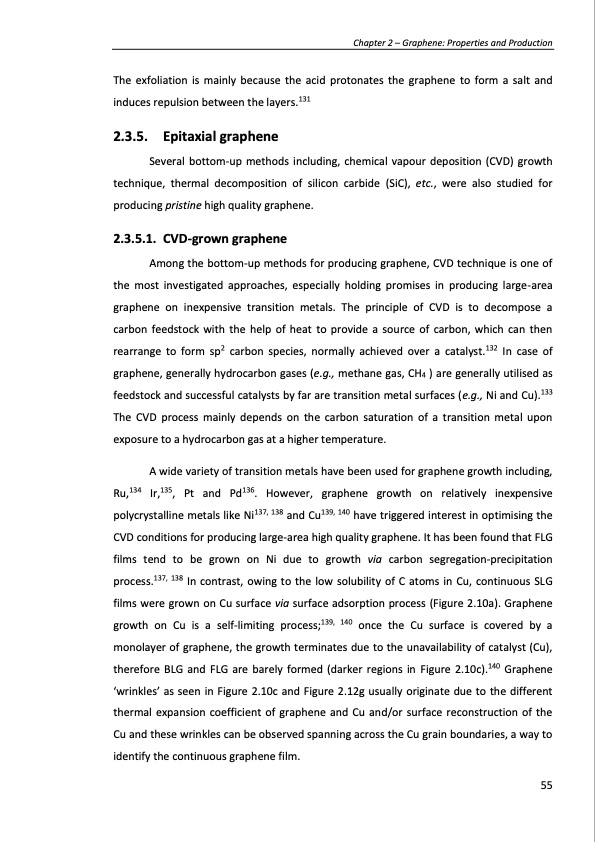PDF Publication Title:
Text from PDF Page: 055
The exfoliation is mainly because the acid protonates the graphene to form a salt and induces repulsion between the layers.131 2.3.5. Epitaxial graphene Several bottom-up methods including, chemical vapour deposition (CVD) growth technique, thermal decomposition of silicon carbide (SiC), etc., were also studied for producing pristine high quality graphene. 2.3.5.1. CVD-grown graphene Among the bottom-up methods for producing graphene, CVD technique is one of the most investigated approaches, especially holding promises in producing large-area graphene on inexpensive transition metals. The principle of CVD is to decompose a carbon feedstock with the help of heat to provide a source of carbon, which can then rearrange to form sp2 carbon species, normally achieved over a catalyst.132 In case of graphene, generally hydrocarbon gases (e.g., methane gas, CH4 ) are generally utilised as feedstock and successful catalysts by far are transition metal surfaces (e.g., Ni and Cu).133 The CVD process mainly depends on the carbon saturation of a transition metal upon exposure to a hydrocarbon gas at a higher temperature. A wide variety of transition metals have been used for graphene growth including, Ru,134 Ir,135, Pt and Pd136. However, graphene growth on relatively inexpensive polycrystalline metals like Ni137, 138 and Cu139, 140 have triggered interest in optimising the CVD conditions for producing large-area high quality graphene. It has been found that FLG films tend to be grown on Ni due to growth via carbon segregation-precipitation process.137, 138 In contrast, owing to the low solubility of C atoms in Cu, continuous SLG films were grown on Cu surface via surface adsorption process (Figure 2.10a). Graphene growth on Cu is a self-limiting process;139, 140 once the Cu surface is covered by a monolayer of graphene, the growth terminates due to the unavailability of catalyst (Cu), therefore BLG and FLG are barely formed (darker regions in Figure 2.10c).140 Graphene ‘wrinkles’ as seen in Figure 2.10c and Figure 2.12g usually originate due to the different thermal expansion coefficient of graphene and Cu and/or surface reconstruction of the Cu and these wrinkles can be observed spanning across the Cu grain boundaries, a way to identify the continuous graphene film. Chapter 2 – Graphene: Properties and Production 55PDF Image | PRODUCTION AND APPLICATIONS OF GRAPHENE AND ITS COMPOSITES

PDF Search Title:
PRODUCTION AND APPLICATIONS OF GRAPHENE AND ITS COMPOSITESOriginal File Name Searched:
graphene-production-applications.PDFDIY PDF Search: Google It | Yahoo | Bing
Salgenx Redox Flow Battery Technology: Power up your energy storage game with Salgenx Salt Water Battery. With its advanced technology, the flow battery provides reliable, scalable, and sustainable energy storage for utility-scale projects. Upgrade to a Salgenx flow battery today and take control of your energy future.
CONTACT TEL: 608-238-6001 Email: greg@infinityturbine.com (Standard Web Page)